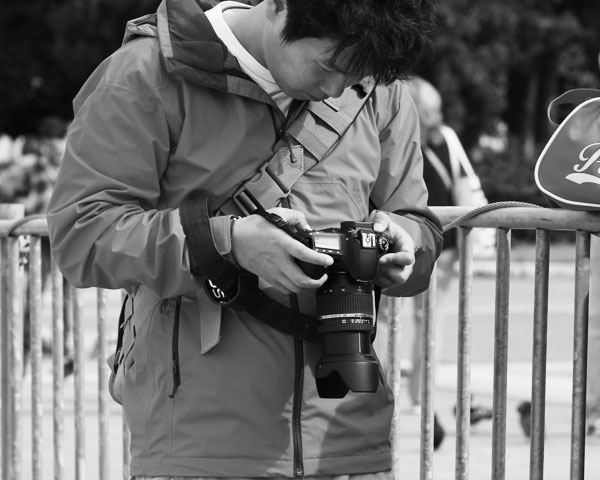 Last week I wrote about the advances you can make in your photography by switching to a prime lens. The core of my argument is that by simplifying your modus operandi, you give yourself leeway to focus on other, more important aspects of your craft, like light and composition.
Last week I wrote about the advances you can make in your photography by switching to a prime lens. The core of my argument is that by simplifying your modus operandi, you give yourself leeway to focus on other, more important aspects of your craft, like light and composition.
Continuing the theme of simplification, this week I want to share another very straightforward change you can adopt to allow you to focus even more carefully on your key skills: turn off the image preview.
Switch Off The Preview
Image preview is a standard feature on most cameras nowadays, where the default behaviour is to immediately show you on the LCD screen the photograph you just shot. Some cameras allow you to adjust the amount of time the image remains on the screen. And every camera (that I’m aware of) will allow you to switch off the preview.
Get The Chimp Off Your Back
There’s a phrase in photography for the act of immediately checking every image you shoot on your camera; it’s called ‘chimping’, and as you may have guessed, it’s not used in a complementary sense. Now there are occasions when it is absolutely ok, even wise to check your LCD screen to make sure your exposure is on the money. But if you find yourself checking excessively then you’re at risk of becoming distracted by your equipment and failing to eke every single good frame out of the scenario that lies before you.
This is particularly true if you are photographing an event, like a wedding for example, or shooting street photography, or sports. In these situations there are so many amazing moments that will pass by unrecorded. In photography, as in life, there is a lot that is out of our control. We can’t be everywhere at once; we can only see the situation from one single vantage point at any given time. It is our job as photographers to know what is in our control, and make conscious decisions about those factors so as to bring home the best possible images we can.
Missed Shots
I’ve learnt this lesson the hard way. The theme that has driven my street photography of late is bicycles in motion. I have a thing for vintage bikes, so I’m always looking for certain types of bikes when I’m out shooting. Usually what I’ll do is find a place to park myself for a while and just see what passes by. It’s a bit like fishing really; I know what I’m looking for, but I don’t know when it’ll come along. More often than I care to mention I’ve found myself checking my images, only to look up and see a beautiful old Japanese Nishiki fly by. Missed shot. Yes I need to check my shutter speed every now and then, but often I just get distracted and wonder if I’m catching anything good.
We live in an age where there are more distractions at our fingertips than ever before, and I think we’ve become less able to fully focus our concentration on one task. I’m sure there are those who would argue that we’re much better multitaskers, but if you want to be a good photographer you need to be able to shut out everything else and focus on one task – making great photographs.
The Price Of A Latte
If you’re working with a subject, creating for example a portrait or a headshot, it’s important to be very judicious about how you use your LCD screen. It’s hard to resist the urge to check that things are working and that you’re achieving the results you were hoping to. Especially when you’re working under the weight of client expectations. But it’s important not to alienate your subject by getting absorbed in that LCD screen. People are often pretty self-conscious in front of the camera, and it’s part of your job as the photographer to reassure them that this is a perfectly normal situation, and that you are totally on top of everything. If you stand there looking at your LCD screen with a furrowed brow after every shot, that’s going to draw attention to the process and make them feel even more self-conscious. I always try to chat with my subjects about anything and everything; the weather, their job, the price of a latte, anything to distract from the dreaded camera. By necessity I need to take test frames and make adjustments to my lighting, but I try to do so while keeping everything nice and relaxed.
I got a great tip in photography school that I always keep in mind: never show a bad reaction to what you see on the back of your camera. The reason is that it can really knock your subject’s confidence. Always react as if everything is going superbly, exactly as planned.
“And hold that smile … wonderful”
[Terrible pose, awful background]
“Perfect. Now, let’s try something else”
Use Positive Language
When you pepper your language with positive words, it creates a positive atmosphere. Your subjects will pick up on that and respond with even better expressions. I was doing a portrait session with a lovely couple from Dallas recently and I was doing my usual photographer impression, blurting out ‘Beautiful!’ every few seconds, and the woman said ‘Justin, every time you say ‘Beautiful’ I feel on cloud 9!’.
Another tip I got at photography school was to be very careful about showing images to subjects, mid-shoot. That little LCD screen can be very deceptive. Often you’ll get back to your computer and realise that photo you fell in love with on the back of your camera is actually out-of-focus. And if you’ve already shown it to your client, you’ve got a pretty awkward conversation in store.
Shoot Tethered
If previewing images on location is important for your client, for example if you’re shooting a corporate or commercial gig, you can do something called ‘tethered shooting’, whereby you connect your camera right to your laptop and transfer the images straight to the computer where you can view them at a decent resolution. You do need a software solution to enable this, like Adobe Lightroom. I personally really like this process, because you can get sign-off from your client on the spot, and go home knowing that everyone is happy.
I hope you’ll follow my advice and switch off that image preview. I truly believe it will help you get more fully in tune with the craft of photography and result in more effective images. You know you can even out some masking tape over the screen as a little reminder – provided you have a viewfinder of course!





That’s a really interesting perspective Gerry! Thanks a million for the comment.
You’re preaching to the converted – I wholeheartedly agree with you on this. I ‘grew up’ using film SLRs, so looking through the eyepiece was the only viewing I got to do. The beauty of that was that I had to trust that I had at least one or two good shots, and focused on technique a lot.
Perfecting technique, and being confident in one’s abilities, allows you to then focus on the the most important aspect, the subject! I started out a wedding photographer and ended up a photojournalist, and as you quite rightly point out, interaction with your subject is vital to producing a good, lively shot.
I worked at a weekly newspaper and was issued ONE roll of 36 ASA100 (if I was lucky, a roll of ASA200). With that one roll, I had to produce all the photos for the paper for that week – front page, social, sports. That forced me to become VERY selective with my shots, and to focus on composition and lighting.
Digital cameras made photography a lot easier, for amateurs and people that had never studied photography. But they also make it more difficult. I don’t believe digital will ever match the quality, depth, shading, and richness of colour, of film. DSLRs also enable people to take a number of frames of the same subject, hoping that they produce at least ONE good print, which then requires time-consuming sifting through a heap of photos that all look very similar. Even though I shoot using a DSLR, I rarely take more than two frames of the same subject, and always use the viewfinder with the viewing screen switched off.
The stock response I get from some of my subjects: “Don’t you need to take more than just two photos?”
Comments are closed.